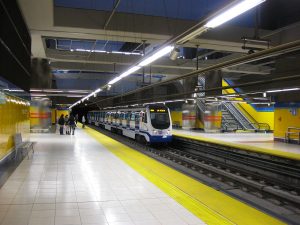 The European Investment Bank (EIB) is proposing a EUR 372 million financing for the construction of Madrid metro Line 11 extension between Conde Casal station and Plaza Elíptica station.
The European Investment Bank (EIB) is proposing a EUR 372 million financing for the construction of Madrid metro Line 11 extension between Conde Casal station and Plaza Elíptica station.
EUR 744 million is the estimated value of the project covering the construction of a 7 km underground metro line. The project also comprises five underground metro stations of which three new stations – Comillas, Madrid Rio, Palos de la Frontera, while the existing Atocha Renfe and Conde de Casal underground metro stations will be refurbished.
The extension will link Madrid from the southwest to the northeast, between Cuatro Vientos and Valdebebas and will connect 11 of the 12 underground lines, linking seven of Madrid’s transport interchanges and reaching strategic points for mobility, such as Madrid Puerta de Atocha station and Madrid-Barajas Adolfo Suárez Airport.
The project will be executed in phases and will integrate the extensions that are already planned for Line 11 of the metro, from Plaza Elíptica to the future Conde de Casal interchange and the extension of the metro to the new developments in Valdebebas.
The Madrid metro Line 11 extension will contribute to reduce pollution and greenhouse gas (GHG) emissions and improve the air quality levels of the local environment by promoting a modal shift from the private car and bus users to cleaner and more efficient metro system.
The authorities plan to transform the Line 11 into a Diagonal line by a 7.2 km north extension from Mar del Cristal to Valdebebas Norte, a 8 km central section between Conde de Casal and Mar del Cristal and a 18.3 km metro extension between Cuatro Vientos and Conde de Casal.
When completed, the 8.5 km existing Line 11 will benefit 33.5 km metro extensions and will become the longest metro line of the Spain’s capital.
Metro de Madrid’s new diagonal line is part of the projects that the Regional Ministry of Transport presented to the European Union’s Recovery and Resilience Fund for funding, with which it seeks to promote a mobility model in the community of Madrid that’s based on technological innovation, greater intermodality, high-capacity public transport and maximum environmental sustainability.
Share on:



